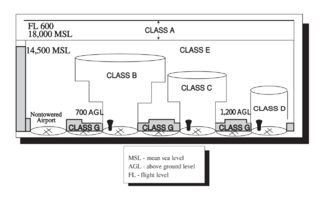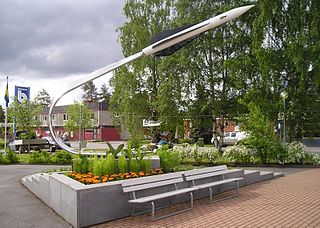Related Research Articles
In aviation, visual flight rules (VFR) are a set of regulations under which a pilot operates an aircraft in weather conditions generally clear enough to allow the pilot to see where the aircraft is going. Specifically, the weather must be better than basic VFR weather minima, i.e. in visual meteorological conditions (VMC), as specified in the rules of the relevant aviation authority. The pilot must be able to operate the aircraft with visual reference to the ground, and by visually avoiding obstructions and other aircraft.

Kiruna is the northernmost town in Sweden, situated in the province of Lapland. It had 17,002 inhabitants in 2016 and is the seat of Kiruna Municipality in Norrbotten County. The city was originally built in the 1890s to serve the Kiruna Mine.

A sounding rocket or rocketsonde, sometimes called a research rocket or a suborbital rocket, is an instrument-carrying rocket designed to take measurements and perform scientific experiments during its sub-orbital flight. The rockets are used to launch instruments from 48 to 145 km above the surface of the Earth, the altitude generally between weather balloons and satellites; the maximum altitude for balloons is about 40 km and the minimum for satellites is approximately 121 km. Certain sounding rockets have an apogee between 1,000 and 1,500 km, such as the Black Brant X and XII, which is the maximum apogee of their class. Sounding rockets often use military surplus rocket motors. NASA routinely flies the Terrier Mk 70 boosted Improved Orion, lifting 270–450-kg (600–1,000-pound) payloads into the exoatmospheric region between 97 and 201 km.

Airspace is the portion of the atmosphere controlled by a country above its territory, including its territorial waters or, more generally, any specific three-dimensional portion of the atmosphere. It is not the same as aerospace, which is the general term for Earth's atmosphere and the outer space in its vicinity.

Esrange Space Center is a rocket range and research centre located about 40 kilometers east of the town of Kiruna in northern Sweden. It is a base for scientific research with high-altitude balloons, investigation of the aurora borealis, sounding rocket launches, and satellite tracking, among other things. Located 200 km north of the Arctic Circle and surrounded by a vast wilderness, its geographic location is ideal for many of these purposes.
The Swedish National Space Agency is a Government agency in Sweden operating under the Swedish Ministry of Education and Science. SNSA operates as a key component of the Swedish space programme, which is mostly carried out through international cooperation, and has included a sequence of satellite missions, both national ones and in cooperation with other nations. Furthermore, the agency distributes government grants to research and development, initiates research and development in space and remote sensing, and acts as the Swedish contact in international cooperative efforts.

Vidsel is a locality situated in Älvsbyn Municipality, Norrbotten County, Sweden with 533 inhabitants in 2010. It is situated about 900 km north of Stockholm, Sweden, in the Arctic Circle; Perhaps its earliest history is as a seasonal settlement, but permanent inhabitants have lived here since the 19th century.

In the United States, airways or air routes are defined by the Federal Aviation Administration (FAA) in two ways:
Hopper was a proposed European Space Agency (ESA) orbital spaceplane and reusable launch vehicle. The Hopper was a FESTIP system study design.

The Petrel was a British sounding rocket. The Petrel 1 was launched, like the Skua 1, with 3 Chick booster rockets. The Chick motors were fitted into a Booster Carriage that also carried the two parachutes that brought it back to earth for re-use. The Petrel 1 was 3.34 m long, had a diameter of 19 cm and reached a maximum altitude of 140 kilometres. It was fired from a barrel launcher approximately 60 ft long (18 m).
The world's navigable airspace is divided into three-dimensional segments, each of which is assigned to a specific class. Most nations adhere to the classification specified by the International Civil Aviation Organization (ICAO) and described below, though they might use only some of the classes defined below, and significantly alter the exact rules and requirements. Similarly, individual nations may also designate special use airspace (SUA) with further rules for reasons of national security or safety.

The Balloon-borne Large Aperture Submillimeter Telescope (BLAST) is a submillimeter telescope that hangs from a high-altitude balloon. It has a 2-meter primary mirror that directs light into bolometer arrays operating at 250, 350, and 500 µm. These arrays were developed for the SPIRE instrument on the Herschel Space Observatory. The project is carried out by a multi-university consortium headed by the University of Pennsylvania and which also includes University of Toronto, Brown University, the University of Miami, the University of British Columbia, JPL, INAOE, and Cardiff University. The third flight of BLAST in Antarctica was a scientific success, but much of telescope was destroyed after landing. It has been rebuilt for a flight from Antarctica in the 2010-11 austral summer. This most recent flight of BLAST has a polarimeter to observe the polarized light from star forming cores. The light is polarized due to magnetic fields. It is thought that the magnetic fields inhibit the collapse of the cores. The Herschel Space Observatory does not have a polarimeter.

The United States airspace system's classification scheme is intended to maximize pilot flexibility within acceptable levels of risk appropriate to the type of operation and traffic density within that class of airspace – in particular to provide separation and active control in areas of dense or high-speed flight operations.

Atmospheric satellite or pseudo-satellite is a marketing term for an aircraft that operates in the atmosphere at high altitudes for extended periods of time, in order to provide services conventionally provided by an artificial satellite orbiting in space.
The Sunrise balloon-borne solar observatory consists of a 1m aperture Gregory telescope, a UV filter imager, an imaging vector polarimeter, an image stabilization system and further infrastructure. The first science flight of Sunrise yielded high-quality data that reveal the structure, dynamics and evolution of solar convection, oscillations and magnetic fields at a resolution of around 100 km in the quiet Sun.
Vidsel Air Base is a Swedish Air Force airfield located 15 km west-northwest of the town of Vidsel, in Sweden. It is a critical part of Vidsel Test Range that provides an aerospace test and evaluation asset for Sweden through the Test & Evaluation (T&E) department of Swedish Defence Materiel Administration (FMV).
Vidsel Test Range is a Swedish strategic national test and evaluation asset operated by the Swedish Defence Materiel Administration (FMV), a part of the Swedish Ministry of Defence, near Vidsel.

The RAAF Woomera Range Complex (WRC) is a major Australian military and civil aerospace facility and operation located in South Australia, approximately 450 km (280 mi) north-west of Adelaide. The WRC is operated by the Royal Australian Air Force (RAAF), a division of the Australian Defence Force (ADF). The complex has a land area of 122,188 km2 (47,177 sq mi) or roughly the size of North Korea or Pennsylvania. The airspace above the area is restricted and controlled by the RAAF for safety and security. The WRC is a highly specialised ADF test and evaluation capability operated by the RAAF for the purposes of testing defence materiel.

The Mobile Rocket Base, abbreviated MORABA, is a department of the DLR Space Operations and Astronaut Training in Oberpfaffenhofen near Munich. Since the 1960s, the MORABA has performed scientific high altitude research missions with unmanned rockets and balloons, and has developed the required mechanical and electrical systems. Their operational areas include upper atmosphere research, microgravity research, astronomy, geophysics, materials science, as well as hypersonic research.

The REXUS/BEXUS programme is a cooperation between the German Aerospace Center (DLR) and the Swedish National Space Agency (SNSA) that allows students from higher education institutions to study experiments on board sounding rockets and stratospheric balloons. Through a collaboration with the European Space Agency (ESA), the opportunity has been made available for students across all ESA Member States, Slovenia and Canada. The Swedish Space Corporation (SSC) and the Mobile rocket base (MORABA) of DLR are responsible for the launch. Students are getting support from experts of DLR, ESA, SSC and ZARM. The programme started in 2007.
References
- ↑ Press release Swedish Defence Material Administration and SSC in major joint investment in Vidsel Test Range, 2006-11-13